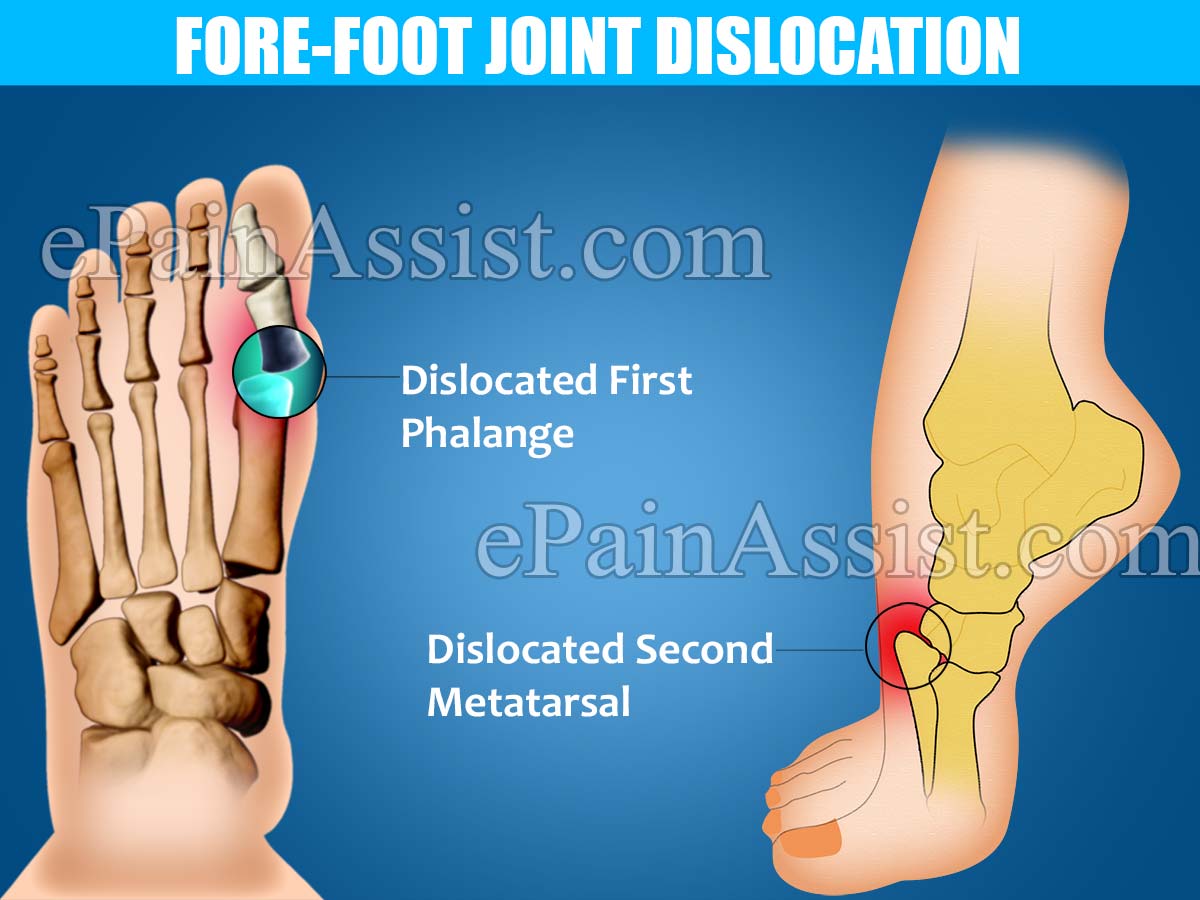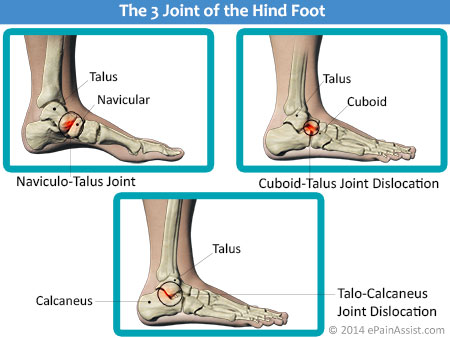Foot contains 26 bones and 33 joints. Dislocation of any of the joint of the foot can cause severe pain. Dislocation of the foot joint affects the weight transmission through the arch of the foot. Body weight is transmitted to ground through the arch of the foot while standing, walking, and jogging. Arch of the foot is mechanically strong and designed to shift the weight to front half and back half of the foot during daily activities. Ligaments, tendons and muscles support bones in maintaining normal anatomical position. Foot is divided in to 3 sections described as front section (fore-foot), middle section (mid-foot) and back section (hind-foot) foot.
Fore-foot is supported by phalanges (toes) and distal ½ of the metatarsal bones. Mid-foot is supported by proximal ½ of the metatarsal bone as well as cuboid, navicular and cuneiform bone. Mid-foot joints form the arch of the foot. Hind-foot is supported by talus and calcaneus bone. Symptoms of foot joint dislocation are spread into one of the three sections.

Types of Foot Joint Dislocation
Fore-Foot Joint Dislocation
Forefoot consists of 5 toes and anterior 1/3rd of the arch of the foot. The 14 phalanges and anterior 1/2 of 5 metatarsal bones support fore-foot.

14 Joints of Forefoot are as Follows-

- Distal Inter-Phalangeal Joint– 4 Joints (includes 4 toes)
- Proximal Inter-Phalangeal Joint- 5 joints (includes 4 toes and big toe)
- Metatarso-Phalangeal Joint- 5 joints
Dislocation of any of the above joint results in acute severe pain and associated symptoms of dislocation.
Mid-Foot Joint Dislocation

The arch of the foot is located in Mid-foot. Following bones support the mid-foot-
- Posterior 1/2 of 5 metatarsal bones.
- 3 Cuneiform bone
- Cuboid bone and
- Navicular bone.
There are 16 joints in mid-foot.
Joints of Mid-foot are as Follows-
- Metatarso-Cuneiform Joint- 1 joint
- Metatarso-Cuboid- 4 joints
- Inter-Metatarsal Joint- 4 joints
- Naviculo-Cuneiform joint- 1 joint
- Naviculo-Cuboid joint- 3 joints
- Cuneiform-Cuboid Joint- 1 joint
- Inter-Cuboid Joint- 2 joints
Dislocation of any of the above joint results in symptoms spread over arch of foot and mid-foot.
Hind-Foot Joint Dislocation
Hind-foot is the continuation of ankle joint and posterior ½ of the arch of the foot. Bones supporting hind-foot are talus, calcaneal, posterior ½ of Navicular and 3 cuboid bones.
The 3 Joint of the Hind Foot are as Follows-
- Naviculo-Talus Joint- 1 joint
- Cuboid-Talus Joint Dislocation- 1 joint
- Talo-Calcaneus Joint Dislocation – 1 joint
Dislocation of any of the above joint results in severe acute foot pain spread over hind-foot.

Symptoms And Signs Of Foot Joint Dislocation
1. Acute Foot Pain
- Foot Pain is described as acute foot pain when pain last for less than 3 to 6 months.
- Similarly, chronic foot pain is defined as pain that continues beyond 3 to 6 months.
- Foot pain when caused by dislocation is always acute and severe during first 3 months.
- Foot pain is associated with severe tenderness over the dislocated joint.
- The skin over dislocated foot joint is bruised, deformed and red.
- Foot pain is localized in one of the 3 sections of foot.
a. Fore-foot Pain-
- Pain is observed over toe and base of toe.
- Pain is caused by dislocation of interphalangeal joints and metatarsophalangeal joint.
- Acute severe pain is often observed following injury or trauma.
- Pain is associated with joint deformity, tenderness and skin discoloration over the dislocated joint.
b. Mid-Foot Pain-
- Severe foot pain associated with deformity and tenderness in mid-foot following injury or accident suggests possible dislocation of one of the 16 mid-foot joint.
- Foot pain is spread over arch of the foot.
- X-Ray and MRI are necessary to diagnose the dislocation of mid-foot, since dermatomal distribution of pain overlaps over adjacent joint.
- Dislocation of mid-foot is divided in front or back of the arch.
c. Hind-Foot Pain-
- Severe foot pain is localized over back of the arch of the foot.
- Foot pain is localized below and front of the ankle joint.
- Pain is associated with deformity and tenderness over the dislocated joint.
- X-Ray and MRI are necessary to diagnose the dislocation.
2. Intensity of Foot Pain
Foot pain is described as mild, moderate, severe and very severe. Pain is measured as VAS (visual analogue score). VAS of the acute and chronic pain are defined as follows-
- VAS zero- no pain
- VAS of 10- optimum severe pain.
- Mild pain- VAS of 1 and 2.
- Moderate pain- VAS of 3 to 5.
- Severe pain- VAS 6 to 8.
- Very severe pain- VAS 9 and 10.
3. Character of Foot Pain
Foot pain is characterized as stabbing and burning pain over dislocated foot joint.
4. Foot Pain with Activities
- Foot pain at rest- Moderate to severe pain
- Pain with activities- Pain is always severe to very severe in intensity.
5. Joint Deformity
- Protrusion of the dislocated bone is observed under the skin
- Deformity is exaggerated by hematoma (blood clot) under the skin and subcutaneous tissue.
- Phalangeal dislocation causes deformity over toes.
- Metatarsal bone dislocation causes deformity of the base of the toes.
- Deformity of the joints of the mid-foot is observed over the arch of the foot.
6. Restricted Foot And Toe Movements
- If the patient is unable to bend or move toes then it indicates dislocation of interphalangeal joint or metatarsophalangeal joint.
- If the patient is unable to perform internal or external rotation of the foot then it suggests dislocation of joints in mid-foot and hind-foot.
7. Bruising of Skin Over Dislocated Joint

a. Bruising Of The Skin Over Toes-
- Purple discolored skin is observed over dislocated toe
- Bruising is caused by subcutaneous bleeding
- Skin is stretched and tender over deformed swollen interphalangeal joint.
b. Bruising Over Arch Of The Foot-
- Purple discolored skin is observed over mid-foot and arch of the foot.
- Bruising is associated with subcutaneous hematoma (blood clot).
- Skin is stretched and tender over deformed swollen mid-foot joint.
Diagnosis Of Foot Joint Dislocation
X-rays of Toe and Foot
- X-Ray-Antero-posterior and lateral X-Ray pictures are examined to diagnose the dislocation of the toe and foot.
- Interphalangeal (toe) and metatarsophalangeal joint (base of the toe) dislocation are often less difficult to diagnose with X-ray.
- X-rays are often repeated in different angle to evaluate mid-foot and hind foot joint dislocation, which are sometimes difficult to evaluate with single X-ray pictures.
MRI of Toe and Foot
- Dislocation of interphalangeal joint (toes) and metatarsophalangeal joint is often diagnosed with X-Ray, and MRI may not be necessary.
- Dislocation of joints in mid-foot and hind-foot often needs MRI studies.
Ultrasound Examination
- Ultrasound is rarely performed.
- Ultrasound is performed when swelling is enormous over the dislocated joint.
- Ultrasound is a high frequency sound wave, which efficiently evaluate the quantity and depth of fluid or blood collected around the dislocated joint.
Blood Examination
- White blood cell count (WBC) – WBC is increased if infection is associated with fracture.
- WBC is also increases when joint swelling is caused by abscess.
- Foot Dislocation https://www.ncbi.nlm.nih.gov/books/NBK554613/
- Dislocation https://my.clevelandclinic.org/health/diseases/17873-dislocation
Also Read:
